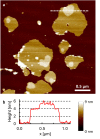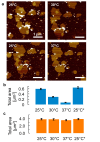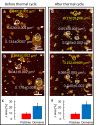Reversible Dissolution of Microdomains in Detergent-Resistant Membranes at Physiological Temperature
- PMID: 26147107
- PMCID: PMC4493071
- DOI: 10.1371/journal.pone.0132696
Reversible Dissolution of Microdomains in Detergent-Resistant Membranes at Physiological Temperature
Abstract
The formation of lipid microdomains ("rafts") is presumed to play an important role in various cellular functions, but their nature remains controversial. Here we report on microdomain formation in isolated, detergent-resistant membranes from MDA-MB-231 human breast cancer cells, studied by atomic force microscopy (AFM). Whereas microdomains were readily observed at room temperature, they shrunk in size and mostly disappeared at higher temperatures. This shrinking in microdomain size was accompanied by a gradual reduction of the height difference between the microdomains and the surrounding membrane, consistent with the behaviour expected for lipids that are laterally segregated in liquid ordered and liquid disordered domains. Immunolabeling experiments demonstrated that the microdomains contained flotillin-1, a protein associated with lipid rafts. The microdomains reversibly dissolved and reappeared, respectively, on heating to and cooling below temperatures around 37 °C, which is indicative of radical changes in local membrane order close to physiological temperature.
Conflict of interest statement
Figures




References
Publication types
MeSH terms
Substances
Grants and funding
LinkOut - more resources
Full Text Sources
Other Literature Sources
Miscellaneous

